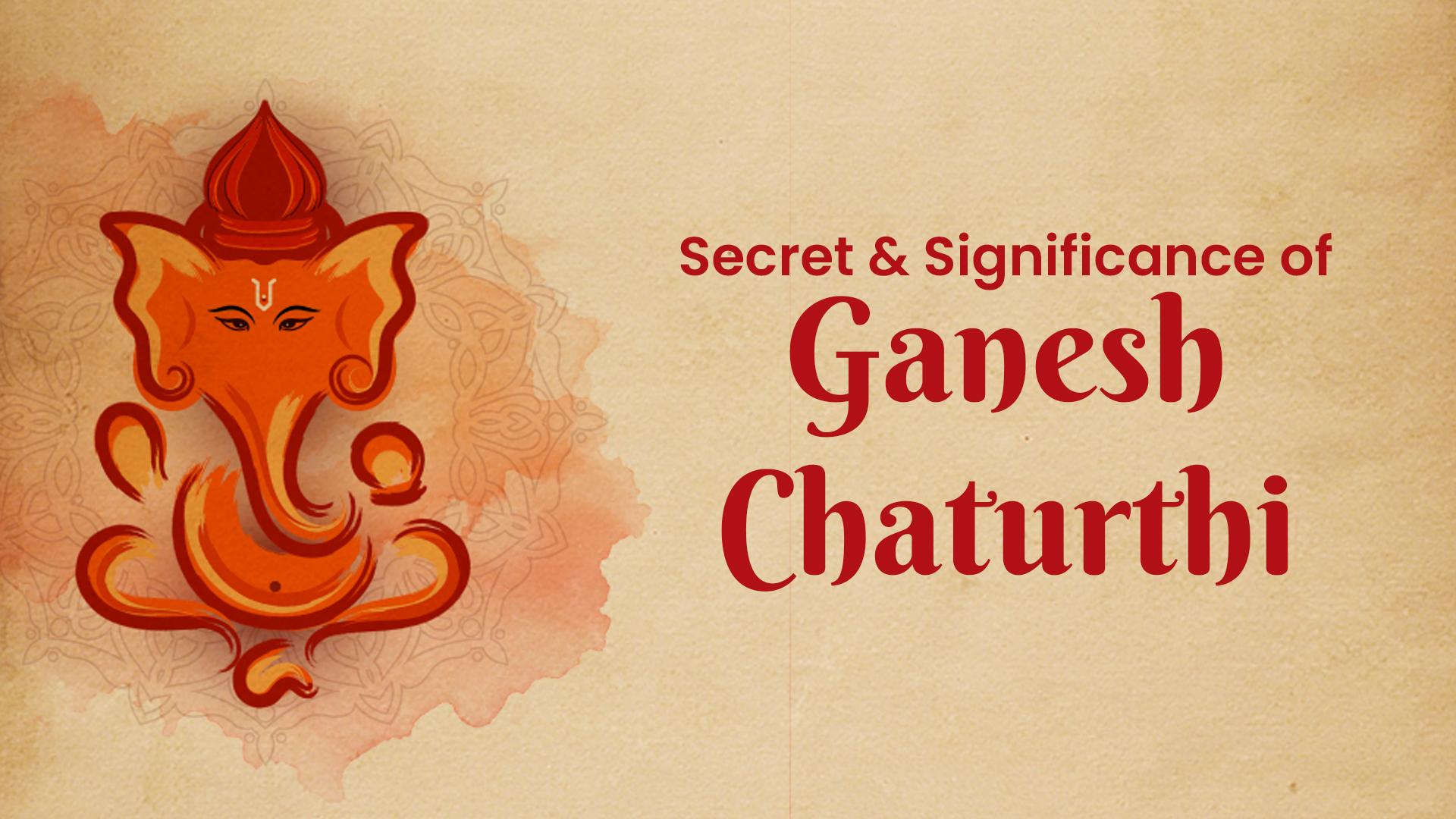Namaskar,
In the Brahma Vaivarta Purana, there is a story of Lord Ganesha’s birth, where a specific name is given to him – Dvaimatura, meaning the son of two mothers.
And there is a verse that appears there:
दव्योर्मात्रोरपत्यंपुमान् द्वैमातुर: ।
– ब्रह्मवैवर्त पुराण
Now, with this same word, with this same name, the story of Lord Ganesha’s birth is also connected. In different Puranas, the story may vary slightly. Here, we will look at the story from the Brahma Vaivarta Purana because it is only after understanding this story that we can comprehend the significance of Ganesh Chaturthi.
Once upon a time, the King of the Devas, Lord Indra, went to the banks of the Pushpabhadraka River for a leisurely stroll. At that moment, an Apsara named Rambha also arrived there. They both were enjoying themselves in the water, having playful moments when suddenly the sage Durvasa arrived. While they were still immersed in the water, they respectfully greeted the sage. Now, Sage Durvasa was traveling from the Vishnu Lok (realm) to the Shiva Lok (realm). Lord Vishnu had given him a divine flower called the Paarijata, and he mentioned that the uniqueness of this flower was that whoever placed it on their head, on their forehead, would become powerful, intelligent, and superior among all the deities. No deity would remain above them, even their intellect would be surpassed. They would be the first to be worshipped among all the deities, and they would become powerful and wise.
Upon hearing this, Durvasa Muni wondered who, apart from Indra, would be more deserving of this flower. Thus, Durvasa Muni gave the divine Paarijata flower to King Indra and then left. Indra accepted the flower in his hands, but since he was in a playful mood with Rambha, he decided to place the flower on the head of his elephant, Airavata.
Now, as Vishnu had enchanted the flower in such a way that anyone who accepted it and placed it on their head would become powerful and intelligent, and would be worshipped by all the deities, whoever disrespected it would become powerless. In just a few moments, Indra, the king of Devas, lost all his powers. Rambha left him and because of his own mistakes, Indra insulted Airavata. So, Airavata, the elephant, went away into the forest and started his new life with another female elephant, eventually having offspring of his own.
Meanwhile, in the realm of Lord Shiva, Parvati Ji created a sculpture out of clay, a young boy. Lord Shiva breathed life into it based on the principles of the Jeev Sukt and Srishti Sukt (creation). Since they were known as “jagatha pitrauvande,” meaning the mother and father of the universe, all the deities came to bless their son, except for Lord Shani (Saturn). When Parvati asked why Lord Shani did not come to bless their child, he replied that he was cursed so that anyone he looked at would suffer decapitation, meaning their head would be separated from their body. He did not want the same fate for their child and, therefore, did not come to give his blessings.
Goddess Parvati says, “Do not worry, do not fret, come with certainty to bestow blessings.” So, Lord Shani Maharaj comes to give blessings. A child is placed in his lap and as soon as Shani sees the child, the child’s head is instantly severed. Now, the story is quite detailed, but in brief, following Lord Shiva’s instructions, Lord Vishnu cuts off the head of Airavat, the elephant, and places it on the child.
Now, if we observe, that every child grows up to become Gajanan or Ganesha. Because now, he had the upper part of Airavat, the elephant, placed on him. Hence, Lord Ganesha embodies wisdom, power, and all qualities. Not only that, according to the prediction made on the blessed flower by Lord Vishnu, he is worshipped as the foremost among all deities. Now, if you understand the story carefully, Lord Ganesha gains two mothers, Goddess Parvati and the female elephant through whom he was birthed as Airavat, which is why he is called Dvaimatura.
As his head is that of an elephant, his name became “Gajavaktra”. If you look at this verse from the Brahma Purana, the entire story is encapsulated within this verse. Take a look at the verse:
विष्णुप्रसाद पुष्यं च यन्मुर्ध्निमुनिदत्तकम्।
तद् गजेन्द्रवक्त्र युक्ते गजवक्त्रम् नमाम्यहम् ॥
– ब्रह्मवैवर्त पुराण
Now, the interesting thing is that the entire event took place on the fourth day of the waxing phase of the Bhadrapad month. That is why even today, this day is referred to as Ganesh Chaturthi, which falls in the month of Bhadrapad. A fast is observed from Chaturthi to Chaturdashi, which spans for ten days. And if we want to provide evidence for this entire incident, we can find it in the Shiv Purana. There, Lord Shiva himself recites the following verse:
चतुर्थ्यां त्वम् समुत्पन्नो भाद्रे मासि गणेश्वर ।
असिते च तया पक्षे चन्द्रस्योदने शुभे ॥
– शिवपुराण
If we decode the verse and understand it, it becomes clear that Ganeshji was born on the Bhadrapad Shukla Chaturthi, and that is why the Ganesh Chaturthi fast is observed on that day. Now, while Chaturthi holds such significance, why does it last for ten days? If we observe carefully, we realize that it has become the grandest festival. Navratri is celebrated for nine days, whereas this festival lasts for ten days. So, why is it ten days long? Scholars have explained this by writing commentaries, stating that we have ten directions. Just as we know about the four main directions – North, East, South, and West – there are also four intermediate directions – Northeast, Southeast, Southwest, and Northwest. That totals eight directions. Additionally, there is one sky, called Urdhva, and one underworld, called Adha. So, altogether, we have ten directions. Therefore, Digpal is referred to as the lord of these ten directions. Now, these ten directions provide us with knowledge, power, and the removal of all obstacles. That is why from Chaturthi to Chaturdashi, a ten-day festival is celebrated here.
The interesting part is how this fast should be observed; if we don’t understand it, then we won’t attain the desired outcome of the fast. And that’s why it is necessary to understand how we should observe this fast. Typically, we create grand pandals where we place large idols of Lord Ganesh. Aarti and worship are performed, but our entire focus is more on the entertaining activities. We tend to consider it as a kind of festive atmosphere as if we need to get into a festive mood, which is completely wrong. Because in the Ganesh Purana, Lord Ganesh himself has given different instructions for it, and there is another story mentioned. According to the story, Chandra Dev (the moon god) commits a grave mistake, and that’s why Lord Ganesh curses him, saying that anyone who sees him will be unhappy, and all the gods come and say that if this happens, whoever sees the moon at night will be unhappy.
So, make some changes. Then, Lord Ganesh says that what has been spoken cannot be changed now. So, let’s do this: we keep one day in the entire year when if anyone sees the moon on that day, they will be unhappy, and that day is Bhadrapad Shukla Chaturdashi.
You can refer to the verse spoken by Lord Ganesh himself in the Ganesh Purana:
भाद्रशुक्लचतुर्थ्याम् यो ज्ञानतोडज्ञानतोड़पि वा ।
अभिशापी भवेत्त्त्चन्द्रदर्शनाद् भृशदुःखभाग् ॥
– गणेश पुराण
In other words, whoever sees the moon on Chaturthi will become unhappy. So, from Chaturthi to Chaturdashi, when we observe the ten-day fast, anyone who sees the moon during that time will become unhappy. This is the meaning that people have derived, but the scriptures delve even deeper into this concept. Here, it is not just about seeing the moon in the sky. The Purusha Suktam clearly states such provisions:
चन्द्रमा मनसो जात:।
– पुरुष सूक्त
In other words, the moon is referred to as “mind.”
Therefore, if we decode the verse and understand the commentary of the Acharyas, it becomes clear that during the observance of the Ganesh Chaturthi fast, we should not engage in entertaining activities. The purpose of this fast is to keep our minds in control and live a disciplined life. It is not just about discipline; it is also a time for spiritual practice, knowledge enhancement activities, and engaging in activities that lead to merit acquisition, liberation, or moksha, as emphasized in the scriptures. If we understand the true meaning of Lord Ganesh, then this fact becomes evident. Hence, the Brahma Vaivarta Purana provides the following verse:
ज्ञानार्थवाचको गश्च णश्च निर्वाणवाचक:।
तयोरीशं परं ब्रह्म गणेशं प्रणम्याम्यहम् ॥
– ब्रह्मवैवर्त पुराण
Meaning, how did the name Ganesh come to be? Gan + Ish, which means the lord of the group becomes Ganesh. Now, one meaning of Gan is a group or community. That is why we observe this fast in public places for the benefit of many people. This makes sense, but this is just one meaning of Gan. In the scriptures, the word Gan has another meaning. ‘G’ means knowledge and ‘N’ means liberation or moksha. In other words, after placing Ganeshji in our homes or in a group, we should not engage in entertainment. We should engage in activities that enhance knowledge or liberation. Even today, when we see Ganeshji being installed and worshipped in public or in homes on Ganesh Chaturthi, entertainment continues. The scriptures say that this time is for spiritual talks, meditation, prayer, or activities that enhance knowledge, and one reason for this is the unique alignment of the planets on that day. If, on the day of Ganesh Chaturthi, we engage in creative visualization and manifestation, we can attain whatever we desire. Ganesh ji is not merely called the bestower of success without reason. The reason behind this is that on the day of Ganesh Chaturthi, the planetary positions in the sky are so significant that if we want to remove obstacles from our lives, we can do so, and we can also find remedies to prevent any future obstacles. Even Lord Sri Krishna himself had mentioned this to Yudhishthira, and in the Skanda Purana, there is a clear verse that states that by using Ganesh Chaturthi, which means the fourth day of the bright half of the Bhadrapada month, practitioners can attain all forms of success. This is why Ganesh Chaturthi is also known as Siddhi Vinayak Chaturthi. You can refer to the verse from the Skanda Purana:
सिदध्यन्ति सर्वकार्याणि मनसा चिन्तितान्यपि ।
तेन रव्यातिम् गतो लोके नाम्ना सिद्धिविनायक: ॥
– स्कन्द पुराण
If we have any obstacles in our lives, whether it is their removal or prevention, or ensuring that no obstacles arise in the future.
One more interesting fact is that we often observe that certain gods have control over specific castes or species. For instance, some supernatural beings may have dominance, while others may have dominance over deities. Only Lord Ganesh is such a deity who provides benefits in the human world(Manushya Loka )the world of ancestors(Pitru Lola)and the celestial world(Dev Loka). Therefore, Lord Ganesh works in a way to bring everyone together, to unify all creations. Lord Ganesh is the deity who can become the God of the entire universe. That is why it is clearly stated in the Bhavishya Purana that those who observe the fast of Ganesh Chaturthi receive the blessings of deities and ancestors. This includes the three worlds we mentioned, the human world, the world of ancestors, the celestial world, and even the underworld. By observing the fast of Ganesh Chaturthi in all these worlds, we achieve success in all our endeavors. I will end my post here, as I present a verse from the Bhavishya Purana:
एक्दन्ते जगन्नाथे गणेशे तुष्टिमागते ।
पितृदेवमनुष्याधा: सर्वे तुष्यन्ति भारत॥
– भविष्यपुराण
In the presence of Lord Ganesha, who has a single tusk, all beings including ancestors, deities, and humans attain contentment.
– Bhavishya Purana
Shubham Bhavatu.







